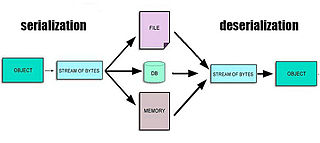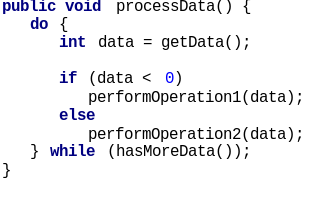Related Research Articles
In computer science, reference counting is a programming technique of storing the number of references, pointers, or handles to a resource, such as an object, a block of memory, disk space, and others.

In computing, serialization is the process of translating a data structure or object state into a format that can be stored or transmitted and reconstructed later. When the resulting series of bits is reread according to the serialization format, it can be used to create a semantically identical clone of the original object. For many complex objects, such as those that make extensive use of references, this process is not straightforward. Serialization of objects does not include any of their associated methods with which they were previously linked.
Java Platform, Standard Edition is a computing platform for development and deployment of portable code for desktop and server environments. Java SE was formerly known as Java 2 Platform, Standard Edition (J2SE).
In multi-threaded computer programming, a function is thread-safe when it can be invoked or accessed concurrently by multiple threads without causing unexpected behavior, race conditions, or data corruption. As in the multi-threaded context where a program executes several threads simultaneously in a shared address space and each of those threads has access to every other thread's memory, thread-safe functions need to ensure that all those threads behave properly and fulfill their design specifications without unintended interaction.
In object-oriented (OO) and functional programming, an immutable object is an object whose state cannot be modified after it is created. This is in contrast to a mutable object, which can be modified after it is created. In some cases, an object is considered immutable even if some internally used attributes change, but the object's state appears unchanging from an external point of view. For example, an object that uses memoization to cache the results of expensive computations could still be considered an immutable object.
In computer programming, a reference is a value that enables a program to indirectly access a particular datum, such as a variable's value or a record, in the computer's memory or in some other storage device. The reference is said to refer to the datum, and accessing the datum is called dereferencing the reference. A reference is distinct from the datum itself.
A dynamic programming language is a type of programming language that allows various operations to be determined and executed at runtime. This is different from the compilation phase. Key decisions about variables, method calls, or data types are made when the program is running, unlike in static languages, where the structure and types are fixed during compilation. Dynamic languages provide flexibility. This allows developers to write more adaptable and concise code.
In computer science, reflective programming or reflection is the ability of a process to examine, introspect, and modify its own structure and behavior.
In computer science, primitive data types are a set of basic data types from which all other data types are constructed. Specifically it often refers to the limited set of data representations in use by a particular processor, which all compiled programs must use. Most processors support a similar set of primitive data types, although the specific representations vary. More generally, primitive data types may refer to the standard data types built into a programming language. Data types which are not primitive are referred to as derived or composite.
In object-oriented programming such as is often used in C++ and Object Pascal, a virtual function or virtual method is an inheritable and overridable function or method that is dispatched dynamically. Virtual functions are an important part of (runtime) polymorphism in object-oriented programming (OOP). They allow for the execution of target functions that were not precisely identified at compile time.
In some programming languages, eval, short for evaluate, is a function which evaluates a string as though it were an expression in the language, and returns a result; in others, it executes multiple lines of code as though they had been included instead of the line including the eval. The input to eval is not necessarily a string; it may be structured representation of code, such as an abstract syntax tree, or of special type such as code. The analog for a statement is exec, which executes a string as if it were a statement; in some languages, such as Python, both are present, while in other languages only one of either eval or exec is.
This article compares two programming languages: C# with Java. While the focus of this article is mainly the languages and their features, such a comparison will necessarily also consider some features of platforms and libraries.

The syntax of Java is the set of rules defining how a Java program is written and interpreted.
In the Java programming language, the final keyword is used in several contexts to define an entity that can only be assigned once.
A foreign function interface (FFI) is a mechanism by which a program written in one programming language can call routines or make use of services written or compiled in another one. An FFI is often used in contexts where calls are made into a binary dynamic-link library.
In computer science, marshalling or marshaling is the process of transforming the memory representation of an object into a data format suitable for storage or transmission, especially between different runtimes. It is typically used when data must be moved between different parts of a computer program or from one program to another.
A symbol in computer programming is a primitive data type whose instances have a human-readable form. Symbols can be used as identifiers. In some programming languages, they are called atoms. Uniqueness is enforced by holding them in a symbol table. The most common use of symbols by programmers is to perform language reflection, and the most common indirectly is their use to create object linkages.
In computer programming, a constant is a value that is not altered by the program during normal execution. When associated with an identifier, a constant is said to be "named," although the terms "constant" and "named constant" are often used interchangeably. This is contrasted with a variable, which is an identifier with a value that can be changed during normal execution. To simplify, constants' values remains, while the values of variables varies, hence both their names.
In computer science, interning is re-using objects of equal value on-demand instead of creating new objects. This creational pattern is frequently used for numbers and strings in different programming languages. In many object-oriented languages such as Python, even primitive types such as integer numbers are objects. To avoid the overhead of constructing a large number of integer objects, these objects get reused through interning.
References
- ↑ "String.Intern Method (String)". Microsoft Developer Network. Retrieved 25 March 2017.
- ↑
String.intern() - ↑ "Chapter 15. Expressions". docs.oracle.com. Retrieved 30 January 2019.
- ↑ "lua-users wiki: Immutable Objects". lua-users.org. Retrieved 30 January 2019.
- ↑ rpetrusha. "String Class (System)". docs.microsoft.com. Retrieved 30 January 2019.
- ↑ "Chapter 5. Conversions and Promotions". docs.oracle.com. Retrieved 30 January 2019.
- ↑ "Java Object Serialization Specification: 1 - System Architecture". docs.oracle.com. Retrieved 30 January 2019.
- ↑ "String.intern in Java 6, 7 and 8 - multithreaded access". java-performance.info. 3 September 2013. Retrieved 30 January 2019.